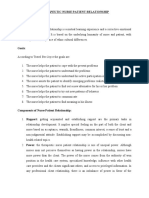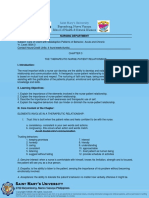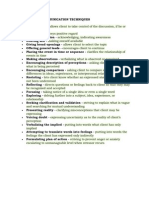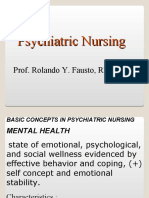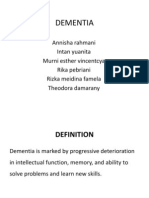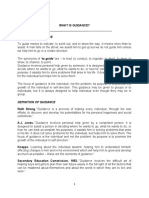Chapter 5 Therapeutic Relationships
Chapter 5 Therapeutic Relationships
Uploaded by
Catia FernandesCopyright:
Available Formats
Chapter 5 Therapeutic Relationships
Chapter 5 Therapeutic Relationships
Uploaded by
Catia FernandesOriginal Description:
Copyright
Available Formats
Share this document
Did you find this document useful?
Is this content inappropriate?
Copyright:
Available Formats
Chapter 5 Therapeutic Relationships
Chapter 5 Therapeutic Relationships
Uploaded by
Catia FernandesCopyright:
Available Formats
CHAPTER 5: Therapeutic Relationships
Chapter 5: Therapeutic Relationships
Key Terms:
o Acceptance: avoiding judgments of the person, no matter what the behavior
o Advocacy: the process of acting on the clients behalf when he or she cannot do so
o Attitudes: general feelings or a frame of reference around which a person organizes knowledge about the
world
o Beliefs: ideas that one holds to be true
o Compassion Fatigue: a type of secondary trauma or stress resulting from helping others works through
traumatic stress; experienced by those in the helping professions
o Confidentiality: respecting the clients right to keep private any information about his or her mental and
physical health and related care
o Congruence: occurs when words and actions match
o Countertransference: occurs when the therapist displaces onto the client attitudes or feelings from his or
her past; process that can occur when the nurse responds to the client based on personal, unconscious
needs and conflicts
o Duty to Warn: the exception to the clients right to confidentiality; when health-care providers are legally
obligated to warn another person, who is the target of the threats or plan by the client, even if the threats
were discussed during therapy sessions otherwise protected by confidentiality
o Empathy: the ability to perceive the meanings and feelings of another person and to communicate that
understanding to that person
o Exploitation: phase of nurse-client relationship, identified by Peplau, when the nurse guides the client to
examine feelings and responses and to a residence where they fulfill their own responsibilities and
function without on-site supervision from paid staff
o Genuine Interest: truly paying attention to the client, caring about what he or she is saying; only possible
when the nurse is comfortable with himself or herself and aware of his or her strengths and limitations
o Intimate Relationship: a relationship involving two people who are emotionally committed to each other;
both parties are concerned about having their individual needs me and helping each other to meet needs as
well; the relationship may include sexual or emotional intimacy as well as sharing of mutual goals
o Orientation Phase: the beginning of the nurse-client relationship; begins when the nurse and client meet
and ends when the client begins to identify problems to examine
o Patterns of Knowing: the four patterns of knowing in nursing are empirical knowing (derived from the
science of nursing), personal knowing (derived from life experiences), ethical knowing (derived from
moral knowledge of nursing), and aesthetic knowing (derived from the art of nursing); these patterns
provide the nurse with a clear method of observing and understanding every client interaction
o Positive Regard: unconditional, nonjudgmental attitude that implies respect for the person
o Preconceptions: the way one person expects another to behave or speak; often roadblock to the formation
of an authentic relationship
o Problem Identification: part of the working phase of the nurse-client situation, when the client identifies
the issues or concerns causing problems
o Self-Awareness: the process by which a person gains recognition of his or her own feelings, beliefs, and
attitudes; the process of developing an understanding of ones own values, beliefs, thoughts, feelings,
attitudes, motivations, prejudices, strengths, and limitations and how these qualities affect others
o Self-Disclosure: revealing personal information such as biographical information and personal
experiences, ideas, thoughts, and feelings about oneself
o Social Relationship: primarily initiated for the purpose of friendship, socialization, companionship, or
accomplishment of a task
o Termination or Resolution Phase: the final stage in the nurse-client relationship; it begins when the
clients problems are resolved and concludes when the relationship ends
o Therapeutic Relationship (Therapeutic Nurse-Client Relationship): professional, planned relationship
between client and nurse that focuses on client needs, feelings, problems, and ideas; interaction designed
to promote client growth, discuss issues, and resolve problems; includes the three phases of orientation:
UNIT 2: Building the Nurse-Client Relationship 1
CHAPTER 5: Therapeutic Relationships
working (identification and exploitation) and termination (resolution); also called therapeutic nurse-
patient relationship
o Therapeutic Use of Self: nurse use themselves as a therapeutic took to establish the therapeutic
relationship with clients and to help clients grow, change, and heal
o Transference: occurs when the client displaces onto the therapist attitudes and feelings that the client
originally experienced in other relationships; it is common for the client to unconsciously transfer to the
nurse feelings her or she has for significant others
o Unknowing: when the nurse admits she does not know the client or the clients subjective world; this
opens way for a truly authentic encounter; the nurse in a state of unknowing is open to seeing and hearing
the clients views without imposing any of his or her values or view points
o Values: abstract standards that give a persona sense of right and wrong and establish a code of conduct for
living
o Working Phase: in the therapeutic relationship, the phase where issues are addressed, problems identified,
and solutions explored; nurse and client work to accomplish goals; contains Peplaus phases of problem
identification and exploitation
Objectives:
o Describe how the nurse uses the necessary components involved in building and enhancing the nurse-
client relationship (trust, genuine interest, empathy, acceptance, and positive regard)
o Explain the importance of values, beliefs, and attitudes in the development of the nurse-client relationship
o Describe the importance of self-awareness and therapeutic use of self in the nurse-client relationship
o Identify self-awareness issues that can enhance or hinder the nurse client relationship
o Define Carpers four patterns of knowing, and give examples of each
o Describe the difference between social, intimate, and therapeutic relationships
o Describe and implement the phases of the nurse-client relationship as outlined by Hildegard Peplau
o Explain the negative behaviors that can hinder or diminish the nurse-client relationship
o Explain the various possible roles of the nurse (teacher, caregiver, advocate, and parent surrogate) in the
nurse-client relationship
UNIT 2: Building the Nurse-Client Relationship 2
You might also like
- Relational PsychotherapyDocument229 pagesRelational Psychotherapykhushi chopra 0050100% (1)
- Forensic Aspects of Dissociative Identity DisorderDocument240 pagesForensic Aspects of Dissociative Identity DisorderDeath Tiscat100% (2)
- Mental Health Nursing Case StudyDocument11 pagesMental Health Nursing Case Studyapi-499028250100% (1)
- Chapter 18 Personality DisordersDocument10 pagesChapter 18 Personality DisordersCatia Fernandes100% (2)
- Core Competencies Under The 11 Key Areas of ResponsibilitiesDocument16 pagesCore Competencies Under The 11 Key Areas of ResponsibilitiesMiden AlbanoNo ratings yet
- Therapeutic Nurse Patient RelationshipDocument7 pagesTherapeutic Nurse Patient RelationshipPrathibha Lydia Braggs DsouzaNo ratings yet
- Chapter 24 Cognitive DisordersDocument7 pagesChapter 24 Cognitive DisordersCatia Fernandes100% (1)
- Chapter 11 Anger, Hostility, and AggressionDocument4 pagesChapter 11 Anger, Hostility, and AggressionCatia Fernandes100% (1)
- CH 22 Neurodevelopmental DisordersDocument7 pagesCH 22 Neurodevelopmental DisordersCatia Fernandes100% (1)
- Chapter 14 Anxiety and Anxiety DisordersDocument4 pagesChapter 14 Anxiety and Anxiety DisordersCatia Fernandes100% (2)
- Chapter 19 Substance AbuseDocument8 pagesChapter 19 Substance AbuseCatia Fernandes100% (1)
- Chapter 2 - Neurobiologic Theories and PsychopharmacologyDocument11 pagesChapter 2 - Neurobiologic Theories and PsychopharmacologyCatia FernandesNo ratings yet
- Chapter 12 Abuse and ViolenceDocument5 pagesChapter 12 Abuse and ViolenceCatia FernandesNo ratings yet
- Chapter 4 Treatment Settings and Theraputic PRogramsDocument5 pagesChapter 4 Treatment Settings and Theraputic PRogramsCatia Fernandes100% (1)
- Pomerantz 2e Chapter01 PowerPointDocument23 pagesPomerantz 2e Chapter01 PowerPointJessica KNo ratings yet
- Daily Teaching Evaluation ChecklistDocument2 pagesDaily Teaching Evaluation ChecklistJayson Alvarez MagnayeNo ratings yet
- Videbeck Chapter 5 Relationship Development - NO NOTESDocument20 pagesVidebeck Chapter 5 Relationship Development - NO NOTESKatie McFarlandNo ratings yet
- NCM 117 - Nurse Patient Interaction - April 2021Document58 pagesNCM 117 - Nurse Patient Interaction - April 2021kimberly dedaseNo ratings yet
- Chapter 3 Psychosocial Theories and TherapyDocument10 pagesChapter 3 Psychosocial Theories and TherapyCatia FernandesNo ratings yet
- Therapeutic Relationship - 2Document45 pagesTherapeutic Relationship - 2Zaraki yami100% (1)
- Chapter 6 Therapeutic CommunicationDocument2 pagesChapter 6 Therapeutic CommunicationCatia Fernandes100% (1)
- NCMB314 Prelim ReadingsDocument77 pagesNCMB314 Prelim ReadingsNine SoleilNo ratings yet
- Alzheimeru2019s DiseaseDocument17 pagesAlzheimeru2019s Diseaseapi-262538456100% (1)
- Nursing Care Plan: Angeles University Foundation College of NursingDocument2 pagesNursing Care Plan: Angeles University Foundation College of NursingRey Ann PangilinanNo ratings yet
- Ethical Legal IssuesDocument29 pagesEthical Legal IssueslisalovNo ratings yet
- Therapeutic CommunicationDocument2 pagesTherapeutic Communicationmarie97% (32)
- Attention Deficit Hyperactivity Disorder (Adhd)Document6 pagesAttention Deficit Hyperactivity Disorder (Adhd)Sheetal PundirNo ratings yet
- Documentation in Psychiatric NursingDocument25 pagesDocumentation in Psychiatric NursingMichelle ErikaNo ratings yet
- NCM 105 Notes 1Document11 pagesNCM 105 Notes 1ApRil Anne BalanonNo ratings yet
- Mini Process Recording Instructions and ExampleDocument9 pagesMini Process Recording Instructions and ExampleStephanie Cook100% (1)
- Psychiatric 2 Nursing-LectureDocument183 pagesPsychiatric 2 Nursing-LectureHarley Justiniani Dela CruzNo ratings yet
- Videbeck Chapter 8 Assessment - NO NOTESDocument22 pagesVidebeck Chapter 8 Assessment - NO NOTESKatie McFarlandNo ratings yet
- Chapter 3 Module The Therapeutic Nurse-Patient RelationshipDocument2 pagesChapter 3 Module The Therapeutic Nurse-Patient RelationshipJaylord VerazonNo ratings yet
- Eating DisorderDocument57 pagesEating DisorderJayselle ArvieNo ratings yet
- Therapeutic Communication TechniquesDocument10 pagesTherapeutic Communication TechniquesJohn Eric Contreras VillegasNo ratings yet
- Psychiatric Nursing SaveDocument1,344 pagesPsychiatric Nursing SavePotchiee PfizerNo ratings yet
- Psychiatric NursingDocument89 pagesPsychiatric NursingJoyVee Pillagara-De LeonNo ratings yet
- Overview of Psychiatric Nursing PracticeDocument5 pagesOverview of Psychiatric Nursing PracticeZam PamateNo ratings yet
- Psychiatric Nursing Notes by Dr. FaustoDocument377 pagesPsychiatric Nursing Notes by Dr. Faustopertru08100% (2)
- Therapeutic CommunicationDocument43 pagesTherapeutic Communicationleanavill100% (1)
- NCM-112-RLE-LEARNING-PACKET-BREAST-CANCER 1st SEM-SY2021-2022Document8 pagesNCM-112-RLE-LEARNING-PACKET-BREAST-CANCER 1st SEM-SY2021-2022Gallannalyn Sanchez100% (1)
- Nursing TheoriesDocument5 pagesNursing TheoriesThuganamix100% (19)
- Roles of NursesDocument3 pagesRoles of NursesRI NANo ratings yet
- Psychiatric NursingDocument20 pagesPsychiatric NursingRI NA100% (1)
- CHAPTER 16 - Schizophrenia 2Document15 pagesCHAPTER 16 - Schizophrenia 2Rebecca100% (1)
- Chapter 17 Mood Disorders and SuicideDocument6 pagesChapter 17 Mood Disorders and SuicideCatia Fernandes100% (2)
- Bipolar 1 Disorder NCPDocument3 pagesBipolar 1 Disorder NCPJoy-Rena Sabinay OchondraNo ratings yet
- The Nursing ProcessDocument9 pagesThe Nursing Processiannello100% (2)
- Stress, Crisis, AnxietyDocument19 pagesStress, Crisis, AnxietyJelly Rose Bajao OtaydeNo ratings yet
- Therapeutic Communication in Psychiatric NursingDocument7 pagesTherapeutic Communication in Psychiatric NursingKatrina BuenconsejoNo ratings yet
- Chapter 7 The Nurse-Client Relationship PDFDocument9 pagesChapter 7 The Nurse-Client Relationship PDFJa YaNo ratings yet
- Therapeutic Communication TechniquesDocument4 pagesTherapeutic Communication TechniquesJustine Plaza100% (1)
- DementiaDocument21 pagesDementiaYuanita IntanNo ratings yet
- Chapter 9 Legal and Ethical IssuesDocument3 pagesChapter 9 Legal and Ethical IssuesCatia FernandesNo ratings yet
- Perioperative Nursing PhaseDocument80 pagesPerioperative Nursing PhaseMary Ann Sambo OgoyNo ratings yet
- Psychiatric NursingDocument130 pagesPsychiatric NursingKiela Nicole Gatpandan AguilarNo ratings yet
- NRG305 Midterm ReviewerDocument22 pagesNRG305 Midterm ReviewerEMMY FLOR VALMORIANo ratings yet
- CLINICAL EVALUATION TOOL Revised 8 12Document6 pagesCLINICAL EVALUATION TOOL Revised 8 12Anonymous 5LgRg6No ratings yet
- Role Case StudyDocument7 pagesRole Case StudyKomal KhanNo ratings yet
- Nursing Process in Psychiatric NursingDocument14 pagesNursing Process in Psychiatric NursingJomark Palgan100% (1)
- 4 PRNTNG Fnal Mental Status Exm-ChecklistDocument3 pages4 PRNTNG Fnal Mental Status Exm-ChecklistLisha Marie GonzagaNo ratings yet
- Maladaptive Patterns of Behavior A. AnxietyDocument19 pagesMaladaptive Patterns of Behavior A. AnxietyTeal Otter100% (1)
- BSN Psy. Version DDocument28 pagesBSN Psy. Version DImraan KhanNo ratings yet
- NCM 105 Lecture PDFDocument556 pagesNCM 105 Lecture PDFNatasha Abdulla100% (4)
- Milieu Therapy / Therapeutic CommunityDocument30 pagesMilieu Therapy / Therapeutic CommunitySaritha SvNo ratings yet
- Maladaptive Patterns of BehaviorDocument97 pagesMaladaptive Patterns of BehaviorKimTot OctavianoNo ratings yet
- Funda Handouts 1Document41 pagesFunda Handouts 1Arn-arn アーン-アーン NopreNo ratings yet
- Talking Therapy: Knowledge and Power in American Psychiatric NursingFrom EverandTalking Therapy: Knowledge and Power in American Psychiatric NursingNo ratings yet
- Midterm - Chapter 2Document22 pagesMidterm - Chapter 2rodamel gundanNo ratings yet
- TheracomDocument83 pagesTheracomStudentnurseMj100% (1)
- Therapeutic RelationshipsDocument61 pagesTherapeutic RelationshipsRao anaNo ratings yet
- Presentation1 TFN Final Term CoverageDocument70 pagesPresentation1 TFN Final Term CoverageJasmin ChavezNo ratings yet
- Unit 6 B Therapeutic Relationship-1Document36 pagesUnit 6 B Therapeutic Relationship-1Nayel ZeeshanNo ratings yet
- Chapter 23 Disruptive Beahvior DisordersDocument5 pagesChapter 23 Disruptive Beahvior DisordersCatia Fernandes100% (1)
- Chapter 20 Eating DisordersDocument5 pagesChapter 20 Eating DisordersCatia FernandesNo ratings yet
- Chapter 16 SchizophreniaDocument9 pagesChapter 16 SchizophreniaCatia FernandesNo ratings yet
- Chapter 21 Somatic Symptom IllnessesDocument5 pagesChapter 21 Somatic Symptom IllnessesCatia Fernandes100% (1)
- Chapter 13 Trauma and Stress-Related DisordersDocument7 pagesChapter 13 Trauma and Stress-Related DisordersCatia FernandesNo ratings yet
- Chapter 15 OCD and Related DisordersDocument4 pagesChapter 15 OCD and Related DisordersCatia FernandesNo ratings yet
- Chapter 9 Legal and Ethical IssuesDocument3 pagesChapter 9 Legal and Ethical IssuesCatia FernandesNo ratings yet
- Chapter 10 Grief and LossDocument6 pagesChapter 10 Grief and LossCatia Fernandes0% (1)
- Chapter 17 Mood Disorders and SuicideDocument6 pagesChapter 17 Mood Disorders and SuicideCatia Fernandes100% (2)
- Chapter 8 AssessmentDocument4 pagesChapter 8 AssessmentCatia FernandesNo ratings yet
- Chapter 7 Clients Response To IllnessDocument7 pagesChapter 7 Clients Response To IllnessCatia FernandesNo ratings yet
- Chapter 1 - Foundations of Psychiatric - Mental Health NursingDocument5 pagesChapter 1 - Foundations of Psychiatric - Mental Health NursingCatia Fernandes100% (2)
- University of The East ManilaDocument21 pagesUniversity of The East ManilaHannah Tolentino-DomantayNo ratings yet
- Portfolio ContentDocument37 pagesPortfolio ContentRhea Mae GastadorNo ratings yet
- Donald E. Polkinghorne - Narrative Knowing and The Human Sciences (Suny Series in Philosophy of The Social Sciences) - State Univ of New York PR (1988)Document252 pagesDonald E. Polkinghorne - Narrative Knowing and The Human Sciences (Suny Series in Philosophy of The Social Sciences) - State Univ of New York PR (1988)Iber AguilarNo ratings yet
- Counselling Psychology Quarterly: To Cite This Article: Adele Frances Campbell & Janette Graetz Simmonds (2011) TherapistDocument16 pagesCounselling Psychology Quarterly: To Cite This Article: Adele Frances Campbell & Janette Graetz Simmonds (2011) TherapistAlexandru NaeNo ratings yet
- Back From The Bluez - 08 - Core BeliefsDocument9 pagesBack From The Bluez - 08 - Core BeliefsCosmina Lungeanu100% (1)
- What Is Clinical Psychology ?: Link No 1Document31 pagesWhat Is Clinical Psychology ?: Link No 1RHIZZA MAE BONGHANOY HITOSISNo ratings yet
- Transforms A Statement Into An Equivalent If-Then Statement. (M8Ge-Iif-2)Document1 pageTransforms A Statement Into An Equivalent If-Then Statement. (M8Ge-Iif-2)ginalynNo ratings yet
- Burger PPT Chapter 3Document35 pagesBurger PPT Chapter 3anam hinaNo ratings yet
- Eaclipt Cpe 2019Document9 pagesEaclipt Cpe 2019inas zahraNo ratings yet
- Outside Medicine: Thomas Gann Maya RuinsDocument3 pagesOutside Medicine: Thomas Gann Maya RuinsPascal FontaineNo ratings yet
- Occupational Therapy Literature Review IdeasDocument6 pagesOccupational Therapy Literature Review Ideasaflsjzblf100% (1)
- Effectiveness of Occupational Therapy Intervention in Borderline Personality Disorder and Post-Traumatic Stress DisorderDocument9 pagesEffectiveness of Occupational Therapy Intervention in Borderline Personality Disorder and Post-Traumatic Stress DisorderTariqual IslamNo ratings yet
- Stefana HistoryofCountertransferenceDocument3 pagesStefana HistoryofCountertransferenceCastro Paredes Hannia CeciliaNo ratings yet
- Guidelines For Schools On The Provision of Counselling For Pupils in SchoolsDocument24 pagesGuidelines For Schools On The Provision of Counselling For Pupils in SchoolsTrupti PurohitNo ratings yet
- Tony Evans, Christiane Sanderson Counselling Skills For Becoming A Wiser Practitioner Tools, Techniques and Reflections For Building Practice WisdomDocument242 pagesTony Evans, Christiane Sanderson Counselling Skills For Becoming A Wiser Practitioner Tools, Techniques and Reflections For Building Practice Wisdomywwonglp89% (9)
- Sobia I KramDocument7 pagesSobia I KramRamya SaravananNo ratings yet
- PTSD and Crime Victimization - PPTDocument42 pagesPTSD and Crime Victimization - PPTVictoria HarganNo ratings yet
- 6 Depression in ChildrenDocument4 pages6 Depression in ChildrenMirza ShaplaNo ratings yet
- Mind Shift How Culture Transformed The Human BrainDocument533 pagesMind Shift How Culture Transformed The Human BrainSophièNo ratings yet
- Psychiatric Nursing PDFDocument50 pagesPsychiatric Nursing PDFRalph Lorenz Avila AquinoNo ratings yet
- Grade 12 Diass Worksheet 2 (2nd Semester)Document4 pagesGrade 12 Diass Worksheet 2 (2nd Semester)Marbe Joy Lindayao AlipongaNo ratings yet
- Hate in The Counter TransferenceDocument9 pagesHate in The Counter Transferencescottperna100% (1)
- Discuss The Goals of Positive PsychologyDocument8 pagesDiscuss The Goals of Positive Psychologylipsy bhattNo ratings yet
- Steiner Repetititon CompulsionDocument13 pagesSteiner Repetititon Compulsionrolando rebolledoNo ratings yet
- Scheme of Work Mindfulness For CoachesDocument17 pagesScheme of Work Mindfulness For CoachesKarolinaOzadowiczNo ratings yet
- The Biomechanical ModelDocument17 pagesThe Biomechanical ModelLama NammouraNo ratings yet





